Inspiration from Roy Underhill, Kari Hultman, and Dan Lauder. THANKS to all! (click any image for a larger version.)
Roy Underhill, author, Colonial era woodworking master, and proprietor of The Woodwright’s Shop, opened his 2009 season with the making of a palm sized grease pot that used a sliding lid and dovetail latch to secure its contents. Some of us live in parts of the country “too sophisticated” to carry a back woods woodworking show on TV. (New York City’s last country music radio station shut down in April of 1983, giving way to light jazz or some other kind of funk.)
So, along comes Kari Hultman, The Village Carpenter, to tell us about her replica of Roy’s little grease pot. Like Kari, I had that project on my to-do list. She got there first with a very nicely made box and some great construction photos.
It was Dan Lauder, and an approaching birthday, that moved the project to the top of the list with his discovery of an 1879 pencil box. While a bit different than the grease pot, the pencil box shared a similar 3 part construction of interlocking parts that qualifies it, like the grease pot, as “clever.”
The lid slides in a dovetailed track. Sliding it out reveals the top tray. That action also unlocks the top tray so that it can swing sideways revealing the bottom of the box. As an aside, the box that Dan discovered had a little pocket in top layer. I don’t know it’s purpose, but in my version, that pocket is now a resting place for a good luck charm, the happy little pig.
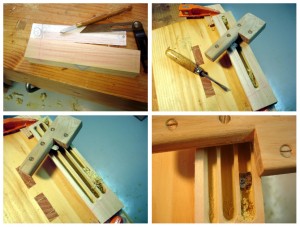 OK, let’s look into how it was made. The lumber was stuff on hand, some tulip poplar. More about that later.
OK, let’s look into how it was made. The lumber was stuff on hand, some tulip poplar. More about that later.
That roughly drawn sketch was my only “plan.” Like Kari, I used only hand tools. Unlike Dan, I don’t have a huge choice of planes, so I routed the pencil grooves with a scratch stock. It was slow going, but worked out OK. It needed more than one scratch. Use your sharp eyes to find my first error. It’s in the very first photo.
![]()
 The sliding lid is about 1/8 inch thick. A router plane provided the space for it, and another small scratch (no photo) made the dovetailed tracks.
The sliding lid is about 1/8 inch thick. A router plane provided the space for it, and another small scratch (no photo) made the dovetailed tracks.
![]()
 The bottom, and the piggy’s nest, were excavated with forstner bits. Back to the router plane for cleanup. The last photo in this sequence shows that error corrected.
The bottom, and the piggy’s nest, were excavated with forstner bits. Back to the router plane for cleanup. The last photo in this sequence shows that error corrected.
![]()
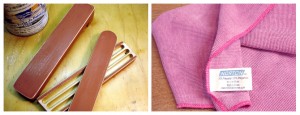 Finishing took more time than building. That’s because I don’t have a clean room for finishing (blame the tools) and I used a very slow drying paint. I wanted to use the same color as the gift recipient’s (not-yet-done) boat, a slow drying enamel. I call it “siren paint,” because as it dries it is constantly singing “Come to Me” to every dust bit in the building. To counteract the dust, I used a hand rubbed finish technique. After a few coats, that technique highlighted the fact that sharp edges need to be rounded to hold paint. So, correction and more coats. As an aside, the Norton tack cloth is a very handy aid. No more waxy cheesecloth.
Finishing took more time than building. That’s because I don’t have a clean room for finishing (blame the tools) and I used a very slow drying paint. I wanted to use the same color as the gift recipient’s (not-yet-done) boat, a slow drying enamel. I call it “siren paint,” because as it dries it is constantly singing “Come to Me” to every dust bit in the building. To counteract the dust, I used a hand rubbed finish technique. After a few coats, that technique highlighted the fact that sharp edges need to be rounded to hold paint. So, correction and more coats. As an aside, the Norton tack cloth is a very handy aid. No more waxy cheesecloth.
Briefly, my hand rubbed finishing regime included: wet sanding with 600 grit, fine sanding with 0000 steel wool, rubbing with pumice, then with rottenstone, and lastly several layers of paste wax to bring to a high satin sheen. For service veterans, “spit shining” is the paste wax method that works best.
Lessons Learned
- Double, triple, quadruple check that angled cuts lean the right way.
- Hardwood would have been a better choice and avoided a few little “dings.” A lot of labor gets invested, and why invest in anything less than the best quality wood?
- Double, triple, quadruple check that angled cuts lean the right way.
- Make the sliding top thicker to lessen bow and give more “meat” to the dovetails.
- Double, triple, quadruple check that angled cuts lean the right way.
- A shellac sealer would have been better than the white sealer I used. The white really shows brightly when edge finish wears.
- Double, triple, quadruple check that angled cuts lean the right way.
- Slow drying paint gathers more dust than fast drying paint. (Doh!)
- Double, triple, quadruple check that angled cuts lean the right way.
- Finish gets really thin on sharp edges. Rounded edges hold finish much better and will wear better. I’ve often read this, but needed to wrestle with the problem myself, and ended up reshaping the work after several rounds of white undercoating showing up as I polished the finish.
- Double, triple, quadruple check that angled cuts lean the right way.
- Hand rubbed finishing takes a lot of time. Well actually, waiting for paint to dry firm enough for hand rubbing take a lot of time.
- Starting 4 days before a birthday isn’t enough time when finishing alone needs 16 days.
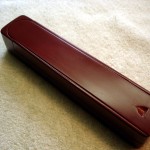
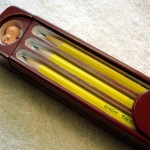
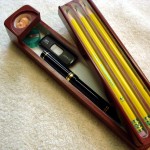
As I remember the little pocket in the pencil layer is for your rubber (or eraser, as you say here.)
Now I wonder where my original box went….
My, that’s a pretty pencil box! And great job on the finish. Finishing always seems to take just as long as it does to build a piece.
Beautiful pencil box, Bob. The finish is wonderful! It’s hard to believe this is poplar. Have you noticed how fun these ‘small’ projects are? I sometimes wonder why I do larger projects 🙂
Cheers — Larry
R Francis,
Thanks. That’s what I thought, but I like the pig better. 🙂
Kari,
When starting this project, I mused that “Kari would decorate it with chip carvings.” I quickly decided that paint would be better, considering my carving skills. Maybe not.
Larry,
Yep, I know. You’re the king of small projects.
Very nice! It’s interesting to see how much you removed with a scratch stock, that’s a lot of scratching! Do you think using a toothed stock for initial coarse removal would have helped before going to the final curved stock? Or maybe alternate scratching with the toothed stock to break up the surface, then the rounded stock to clear it out, then more with the toothed, etc., until you reach the bottom.
And of course every modern pencil box needs a a 2 gig flash drive!
Good questions about a toothed scratch Steve. Since I’ve never tried one, I don’t know if it would have worked better. Maybe on the next one…
The Flash drive has been upgraded to 4GB.
Bob, your pencil box is way better because it has a little pig in it. That trumps just about anything.
Thanks Kari,
The little pig has some background. My wife, the recipient, is Austrian born. The pork industry has always been important in Austria. Good pork is good luck. There is a New Years Day tradition of street vendors and open-air market vendors selling all sorts of these little piggy good luck charms, only on that one day a year. That’s where the little pig came from.
Yet, I know that you would have carved something on such a box.
Wow Bob – very, very cool. Impressive use of the scratch stock – I’ve got to make one of those. The finish looks great, but I don’t think I’d have the patience for that technique. Oh, and I too love the pig.
Do you sell these Pencil boxes? I want one. How much would you sell it for?
No. None for sale.